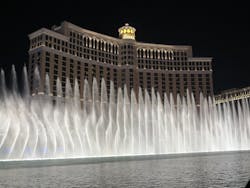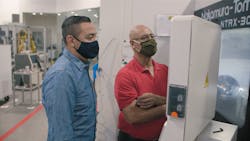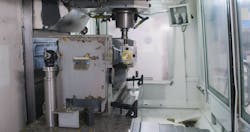ESPRIT Keeps the Success Flowing for WET
Founded in 1983 by former Disney Imagineers, Southern California’s WET Design creates water features that are quite a few cuts above the fountains you might see at your local mall or city park. Their expansive portfolio is an impressive showcase of what’s possible when water, light, music, and human ingenuity come together.
If you’ve ever scrambled for a prime spot to watch the Fountains of Bellagio in Las Vegas, booked a once-in-a-lifetime experience at The Dubai Fountain at Dubai’s Burj Khalifa skyscraper (the tallest building in the world), or stopped to rest at the fountains at Salt Lake City’s City Creek Center, you’ve enjoyed WET’s work. WET installations can be found on three continents and have even made an appearance in the opening and closing ceremonies of the 2002 and 2014 Winter Olympics.
For the last 12 years, WET has relied on ESPRIT computer-aided manufacturing (CAM) software to help them work their magic. “When we first got our mill-turn machines in 2008, we researched the software that would be best able to support our programming needs. ESPRIT was the answer,” says Oscar Ramirez, a top CNC programmer at WET. “We really needed to program our mill-turn parts to get the most from our machines.”
“We program our parts with the CAM system and we can make them with no editing. Previously, we had to do a lot of editing and manual programming to get the machine to make the parts that we needed,” says Oscar. “ESPRIT was the solution because I wanted our focus to be on the machining aspect and more effectively planning our schedule in advance rather than spending a lot of time trying to get a project to come out right.”
Machine swap is an important component of WET’s success on the shop floor. “Machine swap is powerful and keeps us very agile,” says Oscar. “One example is a part we call a spider. It was initially programmed and scheduled to run on our Nakamura machine. The assembly rate went up when the assembly shop added a second shift, so we had to add a second machine to make more spiders.” Machine swap made adding spider assembly to their Haas Trunnion a quick and seamless process that enabled Oscar’s team to keep up with demand.
Oscar cites another part when it comes to saving time. “We used to use two machines to make a part called a skillet,” he says. “That required two long setups. With ESPRIT, we moved that part to the Nakamura machine to make it in one go. That saves us about three hours in setup time, and we need one less machine and one less operator, too.”
If Oscar’s team ever encounters an obstacle, he knows he can count on ESPRIT’s renowned customer service. “I don’t hesitate to go to their portal to ask for help,” he says. “Whether I need help creating a toolpath or need to change a post on our Haas Trunnion, I like the fact that I get a reply the same day and that I know someone is working on it.”
“We’re a project-based company, and sometimes the timeline to develop, produce, and deliver is very short. While we always have a couple of very big projects on the horizon, we expect to get many smaller projects as well,” Oscar says. “As a result of the short turnaround time, we have to constantly keep improving our methods and techniques so we can accommodate these projects, support our existing projects, and keep growing. ESPRIT plays a vital role because we get great toolpaths and the code is correct.”
For more information about ESPRIT, contact: ESPRIT CAM, 1150 Avenida Acaso, Camarillo, CA 93012, USA. Phone 805/388-6000, 800/62-8479, Fax: 805/388-3085, Email: [email protected], or visit www.espritcam.com



